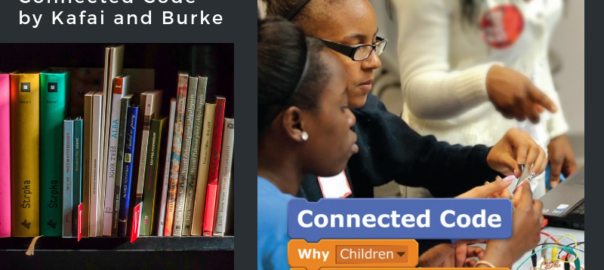Welcome to our Book Club discussion of Connected Code! next book club will be a Twitter Slowchat! If you have not participated in a Twitter Chat before, please follow @CIRCLEducators and the authors of Connected Code Yasmin Kafai @katyaskit and Quinn Burke @QuinnBurke174.
Here are our questions for this book! Please use A.# and #CIRCLEdu when answering questions. For example, to answer Q1:
A1. #CIRCLEdu [the text of your answer]
Please also send all of your own questions to @CIRCLEducators ! And contact us if you need help!
Q1. In Chapter 1, p.9 the authors write “Programming is a form of expressing oneself and of participating in social networks and communities.” How do you and your students use tech tools for computational participation? #CIRCLEdu
Q2. In Chapter 2, p.20 the authors describe how Papert thought of learning: “as building knowledge structures” through the use of artifacts. How do you use technology tools to help students (or you) think about concepts? #CIRCLEdu What tools are you using?
Q3. In Chapter 2, p.23 the authors describe the personal dimensions – the set of informal ideas and theories that are connected to personal experiences – that learners carry with them. How do you help your students make connections between the ideas that already exist and what they are learning in your classroom? #CIRCLEdu
Q4. In Chapter 3, p.36 the authors describe how Debbie was able to apply ideas from programming in Logo to making fraction representations more visually interesting. This shift is described as on from programming code to thinking computationally in terms of the code. Have you been able to see the development of computational thinking skills in your students? How? #CIRCLEdu
Q5. In Chapter 3, p.41 The author’s share Donald Murray’s perspective about writing not being “magical.” They go on to say: “Much like writing three decades ago, computer programming still faces this myth of the ‘magical.’” How are you or others you know making programming a process that students can understand? #CIRCLEdu
Q6. In Chapter 4, p.56 – The authors say that “Motivation to program and persist at troubleshooting their own code increases significantly when they work in pairs.” How do you encourage collaboration in your class? #CIRCLEdu
Q7. What was your favorite quote? Please include the page number! #CIRCLEdu
Q8. In Chapter 6 the authors discuss how to incorporate tangibles and simulations in the classroom. What are some tangible computing projects that you have (or have seen) incorporated in classrooms that really work? Why did it work? #CIRCLEdu
Q9. In Chapter 7, Connected Teaching, the authors discuss supporting learner’s agency (pp. 120-122) as well as Dewey’s idea that “learning activities must be applicable and testable in the worlds that children inhabit outside of the classroom” (p.121). How do you hope that your students might apply what they learn in your classroom/school when they are outside of the classroom? #CIRCLEdu
Q10. In Chapter 8, the authors discuss the reframing of computational thinking to computational participation. What do you think? #CIRCLEdu
How to cite this work
CIRCL Educator posts are licensed under a Creative Commons Attribution 4.0 International License. If you use content from this site, please cite the post and consider adding: "Used under a Creative Commons Attribution 4.0 International License (http://creativecommons.org/licenses/by/4.0/)."
Suggested citation format: [Authors] ([Year]). [Title]. CIRCLEducators Blog. Retrieved from [URL]

